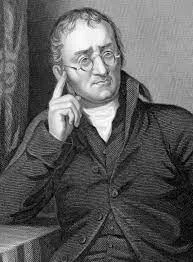-
 The alchemists believed all metals were formed from two principles - mercury and sulfur. They attempted to purify, mature, and perfect certain materials.
The alchemists believed all metals were formed from two principles - mercury and sulfur. They attempted to purify, mature, and perfect certain materials. -
 Plato theorized that these solid forms of matter are composed of indivisible elements shaped like triangles. He proposed that matter was continuous, infinite, and present in every form.
Plato theorized that these solid forms of matter are composed of indivisible elements shaped like triangles. He proposed that matter was continuous, infinite, and present in every form. -
 Democritus theorized that all material bodies are made up of indivisibly small "atoms". He believed differences in atomic shape and size determined the various properties of matter.
Democritus theorized that all material bodies are made up of indivisibly small "atoms". He believed differences in atomic shape and size determined the various properties of matter. -
 Robert discovered that the volume of a gas decreases with increasing pressure and vice versa. This empieral relation in equation is pv=k.
Robert discovered that the volume of a gas decreases with increasing pressure and vice versa. This empieral relation in equation is pv=k. -
 Antone established the law of conservation mass which helped to shape the atomic theory. The law definded that matter is composed of atoms that were not created or destroyed during chemical reactions.
Antone established the law of conservation mass which helped to shape the atomic theory. The law definded that matter is composed of atoms that were not created or destroyed during chemical reactions. -
 John is best know for the atomic theory and his work on human optics. He discovered that all matter is made of atoms which are invisible.
John is best know for the atomic theory and his work on human optics. He discovered that all matter is made of atoms which are invisible. -
 Amedeo's priciple stated that equal volumes of gases at the same temperature and pressure contain the same number of molecules regardless of their chemical nature and physical properties.
Amedeo's priciple stated that equal volumes of gases at the same temperature and pressure contain the same number of molecules regardless of their chemical nature and physical properties. -
 Dmitri discovered the Periodic law. His law allowed him to build up a systematic table of all the elements then known.
Dmitri discovered the Periodic law. His law allowed him to build up a systematic table of all the elements then known. -
 Thompson's expierements showed that all atoms contain tiny negatively charged subtomic particles of electrons. He proposed a model of the atom as a sphere of positive matter.
Thompson's expierements showed that all atoms contain tiny negatively charged subtomic particles of electrons. He proposed a model of the atom as a sphere of positive matter. -
 Pierre and Marie discovered the strongly radioactive elements polonium and radium. They established the new field of nuclear physics.
Pierre and Marie discovered the strongly radioactive elements polonium and radium. They established the new field of nuclear physics. -
 Albert proved the existence of atoms, and thus helped revolutionize all sciences through the use of statistics and probability. It is the theory of relativity that has changed our understanding of the universe.
Albert proved the existence of atoms, and thus helped revolutionize all sciences through the use of statistics and probability. It is the theory of relativity that has changed our understanding of the universe. -
 Robert suceeded in precisely determinding the magnitude of the electrons charge. His work demonstrated that electrons did have a discrete, quantifiable charge.
Robert suceeded in precisely determinding the magnitude of the electrons charge. His work demonstrated that electrons did have a discrete, quantifiable charge. -
 Ernest described the atom as having a tiny and dense core called the nucleus. He established that the mass of the atom is concentrated in its nucleus.
Ernest described the atom as having a tiny and dense core called the nucleus. He established that the mass of the atom is concentrated in its nucleus. -
 Neils proposed a model of the atomin which the elcetron was able to occupy only certain or orbits around the nucleus. The model was the first to use the quantum theory.
Neils proposed a model of the atomin which the elcetron was able to occupy only certain or orbits around the nucleus. The model was the first to use the quantum theory. -
 Mosely's law states that the square root of the frequency of the x-ray emitted by an atom is proportional to its atomic number. This was a milstone in advancing knowledge of an atom.
Mosely's law states that the square root of the frequency of the x-ray emitted by an atom is proportional to its atomic number. This was a milstone in advancing knowledge of an atom. -
 Werner is best known for his uncertainty principle and theory of quantum mechanics. His work led to the discovery of the strong force in an atom's nucleus which is what holds the protons and neutons together.
Werner is best known for his uncertainty principle and theory of quantum mechanics. His work led to the discovery of the strong force in an atom's nucleus which is what holds the protons and neutons together. -
 Erwin theorized that the behavior of electrons within atoms could be explained by treating them mathematically as matter waves. He formulated a wave equation that calculated the energy levels of electrons in atoms.
Erwin theorized that the behavior of electrons within atoms could be explained by treating them mathematically as matter waves. He formulated a wave equation that calculated the energy levels of electrons in atoms. -
 James found that the atoms consisted of protons and electrons and another sub-atomic particle called the neutron. He proved the existence of neutrons.
James found that the atoms consisted of protons and electrons and another sub-atomic particle called the neutron. He proved the existence of neutrons.